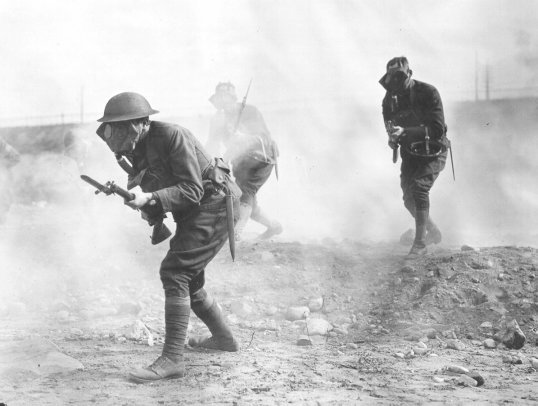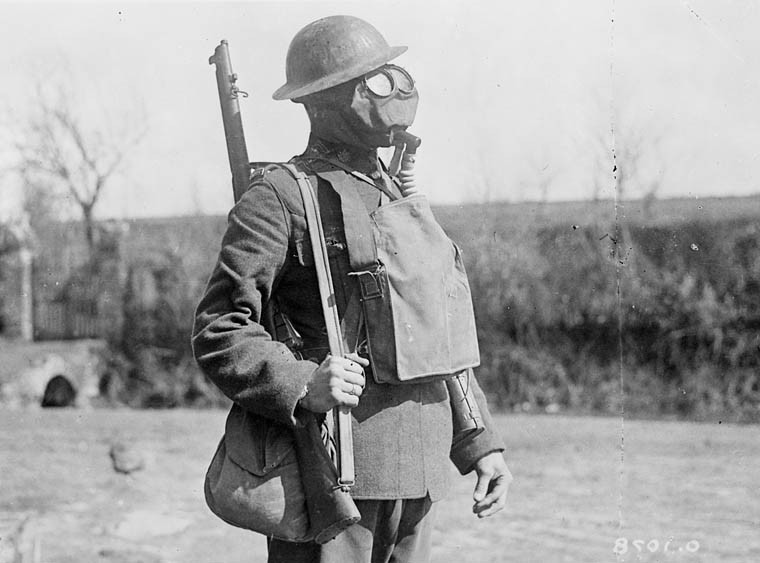MUSTARD GAS AND ITS EFFECTS ON HUMAN BODY
The sulfur mustards, or sulphur mustards, commonly known as mustard gas, are a class of related cytotoxic and vesicant chemical warfare agents with the ability to form large blisters on the exposed skin and in the lungs. Pure sulfur mustards are colorless, viscous liquids at room temperature. When used in impure form, such as warfare agents, they are usually yellow-brown in color and have an odor resembling mustard plants, garlic or horseradish, hence the name. Mustard gas was originally assigned the name LOST, after the scientists Wilhelm Lommel and Wilhelm Steinkopf, who developed a method for the large-scale production of mustard gas for the Imperial German Army in 1916.
Mustard agents are regulated under the 1993 Chemical Weapons Convention (CWC). Three classes of chemicals are monitored under this Convention, with sulfur and nitrogen mustard grouped in Schedule 1, as substances with no use other than in chemical warfare. Mustard agents could be deployed on the battlefield by means of artillery shells, aerial bombs, rockets, or by spraying from warplanes.
Sulfur mustard is the organic compound with formula:
Cl-CH2-CH2-S-CH2-CH2-Cl
MECHANISM OF TOXITICY
Chlorine is in the halogen group and is the second lightest halogen after fluorine. The element is a yellow-green gas under standard conditions, where it forms diatomic molecules. It has the highest electron affinity and the third highest electronegativity of all the elements; for this reason, chlorine is a strong oxidizing agent. In the form of chloride ions, chlorine is necessary to all known species of life. Other types of chlorine compounds are rare in living organisms, and artificially produced chlorinated organics range from inert to toxic. Elemental chlorine at high concentrations is extremely dangerous and poisonous for all living organisms, and was historically used in World War I as the first gaseous chemical warfare agent.
Chlorine forms a variety of oxides, as seen above: chlorine dioxide (ClO2), dichlorine monoxide (Cl2O), dichlorine hexoxide (Cl2O6), dichlorine heptoxide (Cl2O7). HClO oxidizes sulfhydryl groups of proteins and interacts with the unsaturated bonds of membrane lipids by altering and changing the permeability (fluid accumulation in the extracellular space, especially in the respiratory tract).
The compound readily eliminates a chloride ion by intramolecular nucleophilic substitution to form a cyclic sulfonium ion. This very reactive intermediate tends to permanently
alkylate the guanine nucleotide in DNA strands, which prevents cellular division and generally leads directly to programmed cell death, or, if cell death is not immediate, the damaged
DNA may lead to the development of cancer. Sulfur mustard is not very soluble in water but is very soluble in fat, contributing to its rapid absorption into the skin. In cell a nucleophilic substitution causes the intramolecular cyclization of the chain 2-cloroetilica, with formation of an ion cyclic intermediate extremely reactive and the formation of HCl.
The ion intermediate ethylene-sulphonic acid is able to react with various cellular substrates, such as sulfhydryl groups of proteins, amino
or nucleobases. The formation of hydrochloric acid explains the
effects blisters and burns. The affinity to interact with the nitrogenous bases of
DNA do you explain the interference with cell replication.
Thanks to its liposolubility is able to rapidly penetrate deep into skin causing lesions very painful. The target of the radicals of chlorine are the cells of the germinal layer of the epidermis, they cause burns, sores, ulcers and dermatitis.
When vaporized, for example by means of an explosion, mustard gas spreads in the air and if inhaled, causes serious damage all the respiratory: tissue edema and difficulty breathing.
The mustard gas also affects the cornea, causing conjunctivitis, blepharospasm and cheratinite.

Concentrations of about 0.15 mg / liter of air are lethal in about 10 minutes. The exhibition, even for a short time, causes severe immunosuppression with leukopenia plus opportunistic infections consequential injury to the skin. The whole determines the exitus in less than a week. The fact that mustard gas and related compounds of inducing leukopenia: led physicians interested in the benefits for the treatment of leukemia and Hodgkin's disease.

NITROGEN MUSTARDS
Replacing the sulfur atom a nitrogen atom, will synthesize the nitrogen mustards, much less toxic, but more subtle because less odorous. The general chemical structure is as follows:
R-N(CH2CH2Cl)2
They possess less potent vesicant action of mustard, but they pass more easily through the skin. They are irritating at low doses, at higher doses produce necrosis of the exposed tissue; already in modest doses eyes and mucous membranes of the respiratory tract are heavily damaged, in large doses the death occurs in a few days, with the same typical lesions of hyprites. They irreversibly block cell mitosis.
Before and during World War II were synthesized numerous nitrogen mustards, which were not used in the conflict, although the Italians have used on several occasions in 1930 in Sirtica (Libya) and in 1936 during the war in Ethiopia.
Pharmacologists Alfred Gilman and Frederick Philips studied the effects of mustard gas, were convinced that it might play a role therapy in cancer. They synthesized molecules similar mustard, obtained by replacing the central atom of sulfur with a nitrogen atom and they observed the antiproliferative action on the growth of experimental tumors and cytotoxic activity of different tissues.
Gilman immediately perceived that sulfur compounds such as mustard interfering with cell replication, but caused the death of the experimental animals at very low doses. Therefore folded molecules of very similar but obtained replacing the central atom of sulfur with a nitrogen atom: the azo-ipriti or nitrogen mustard.
The Mechlorethamine become the first agent alkylating agent used in cancer therapy. changing and optimizing the structure of the first mustards azotatate were born, in sequence, molecules that are still in trade and use in therapy. They are capable of react with DNA, by alkylating the nitrogen 7 of guanine and thus interfering with the replicative cellular processes. The alkylation, in fact, also happens with other components cell containing sulfhydryl, amino, carboxylic and phosphate groups. The interaction with the DNA can occur on the same strand, between nucleobases adjacent or on opposite strands. Today, the most widely used antineoplastic agent is chlorambucil that has a cytotoxic effect very powerful.
PHOSGENE
Phosgene is a choking gas that was used together with mustard gas. It doesn’ t create immediate effects, but after 24 – 72 hours. Although it is somewhat hydrophobic, phosgene reacts with water to release hydrogen chloride and carbon dioxide:
COCl2 + H2O → CO2 + 2 HCl
The hydrogen chloride dissolves cells’ membranes causing the filling of the respiratory tract of liquid. Death occurs by a combination of internal bleeding, shock and respiratory failure. Unlike other gas, phosgene is not absorbed through the skin, its effect is produced only by inhalation.
During or immediately after exposure to dangerous concentrations of phosgene, the following signs and symptoms may develop:
◦Coughing
◦Burning sensation in the throat and eyes
◦Watery eyes
◦Blurred vision
◦Difficulty breathing or shortness of breath
◦Nausea and vomiting
◦Skin contact can result in lesions similar to those from frostbite or burns
◦Following exposure to high concentrations of phosgene, a person may develop fluid in the lungs (pulmonary edema) within 2 to 6 hours.
Exposure to phosgene may cause delayed effects that may not be apparent for up to 48 hours after exposure, even if the person feels better or appears well following removal from exposure. Therefore, people who have been exposed to phosgene should be monitored for 48 hours afterward. Delayed effects that can appear for up to 48 hours include the following:
◦Difficulty breathing
◦Coughing up white to pink-tinged fluid (a sign of pulmonary edema)
◦Low blood pressure
◦Heart failure
Today it is used in the in industry to produce many other chemicals such as pesticides.
HISTORY
DEVELOPMENT
Mustard gas was developed in 1822 by César-Mansuète Despretz. Only in 1860, the British scientist Frederick Guthrie synthesized and characterized the mustard gas compound, and he also noted its irritating properties.
In 1886, Viktor Meyer combined 2-chloroethanol with aqueous potassium sulfide, and then treated the resulting thiodiglycol with phosphorus trichloride. Meyer had this compound tested on laboratory rabbits, most of which died.
In 1913, the English chemist Hans Thacher Clarke replaced the phosphorus trichloride with hydrochloric acid in Meyer's formulation while working with Emil Fischer in Berlin. Clarke was hospitalized for two months for burns after one of his flasks broke. Fischer reported on this accident to the German Chemical Society sent the German Empire on the road to chemical weapons.
USE
Mustard gas was first used effectively in World War I by the German army against British soldiers near Ypres, Belgium, in 1917. The name Yperite comes from its usage by the German army near that town.
The Allies did not use mustard gas until November 1917 at Cambrai, France, after the armies had captured a stockpile of German mustard-gas shells. It took the British more than a year to develop their own mustard gas weapon. This was used first in September 1918 during the breaking of the Hindenburg Line.

Mustard gas was dispersed as an aerosol in a mixture with other chemicals, giving it a yellow-brown color and a distinctive odor. Mustard gas has also been dispersed in such munitions as aerial bombs, land mines, mortar rounds, artillery shells, and rockets. Exposure to mustard gas was lethal in about one percent of cases. Its effectiveness was as an incapacitating agent. The early countermeasures against mustard gas were relatively ineffective, since a soldier wearing a gas mask was not protected against absorbing it through his skin and being blistered.
GAS MASK
A gas mask is a mask put on over the face to protect the wearer from inhaling airborne pollutants and toxic gases. The mask forms a sealed cover over the nose and mouth, but may also cover the eyes and other vulnerable soft tissues of the face. Some gas masks are also respirators. The user of the gas mask is not protected from gas that the skin can absorb.
The first model of gas mask supplied by army consisted of a simple form of gauze inside of which was placed cotton soaked in alkaline salts, which were capable of neutralizing gases containing chlorine and bromine.
Gas masks have a limited useful lifespan that is related to the absorbent capacity of the filter. Once the filter has been saturated with hazardous chemicals, it ceases to provide protection and the user may be injured. Most gas masks use sealing caps over the air intake to prevent the filter from degrading before use, but the protective abilities also degrade as the filter ages or if it is exposed to moisture and heat. Very old unused gas mask filters may not be effective at all in protecting the user, and can even potentially cause harm to the user due to long-term changes in the filter chemical composition.

CHLORINE POISONING TODAY
Used to prevent the growth of bacteria, chlorine is used as a disinfectant, commercial and industrial, most commonly in swimming pools and water treatment plants. Once it enters the body, the chlorine becomes extremely corrosive and toxic, requiring immediate medical attention.Often used for the production of pesticides, refrigerants and products for cleaning and disinfection, chlorine is easily detected by its pungent odor. Most cases of poisoning occur when the powder is mixed with chlorine bleach, with consequent release of chlorine gas. Even when used in low concentrations, chlorine can have a devastating effect on individuals, if used, stored or handled improperly. The ability of chlorine to form hydrochloric acid and hydrochlorus when it reacts with the moisture is what makes it so dangerous.
Fabio Peano, Mattia Bernardi